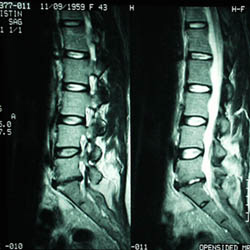MRI - Magnetic Resonance Imaging
What is MRI?
Magnetic Resonance Imaging (MRI) is today's imaging "gold standard." MRI combines computer technology, a magnetic field, and radio waves to produce a two-dimensional image of a "slice" of the patient’s anatomy. This process is radiation free, and the radio waves are harmless.
Unlike CT scans and x-ray images, MRI scans produce highly detailed images that are adept at identifying soft tissue pathologies. Another advantage of MRI is that it can produce images in different anatomical planes, enabling study of the anatomy from different angles. MRI can help us to identify various spinal pathologies including infection, nerve impingement, disc herniation, spinal cord compression, low back and neck pain, and tumor.

| Anatomical Plane | Description |
| Coronal Plane (Frontal Plane) | Separates the body vertically from head to toe into front and back halves. |
| Sagittal Plane (Lateral Plane) | Separates the body vertically from head to toe and into left and right sides. |
| Axial Plane (Transverse Plane) | Separates the body horizontally at the waist, i.e. top and bottom halves of the body. |
MRI Equipment
At the start of the scanning process, the patient lies on a padded motorized table that slides in and out of the MRI "tube". Three powerful magnets surround the patient when positioned inside the MRI tube. Some newer MRI machines are "open" at the sides. Open scanning is of great benefit to claustrophobic patients, although the images produced are sometimes not as good quality as generated by "traditional" MRI equipment.
The technician operates the MRI machine from a room adjacent to the patient area, which is shared by a large window. The technician is able to see and communicate with the patient during the entire procedure. The operation of the equipment from a separate area is necessary to protect the computer from the powerful magnetic forces.
Pre-Test Preparation
The MRI equipment and the scanning process can intimidate some patients. At our practice we are aware of these concerns, and we take all steps necessary to ensure your comfort.
An MRI requires no special physical preparation. The patient does not need to restrict food or fluids prior to the test, unless a contrast medium (dye) will be used. If a contrast agent is to be used, the patient will be given individualized pre-test instructions.
Prior to the test, the patient will be asked to remove all jewelry and metal objects and put on a medical gown.
Some patients are not MRI candidates. Restrictions include:
- Pacemaker
- Aneurysm clips
- Certain metallic orthopaedic and dental implants, including some stainless steel spinal implants
- Physically too large
- Pregnancy (risks to fetus unknown)
